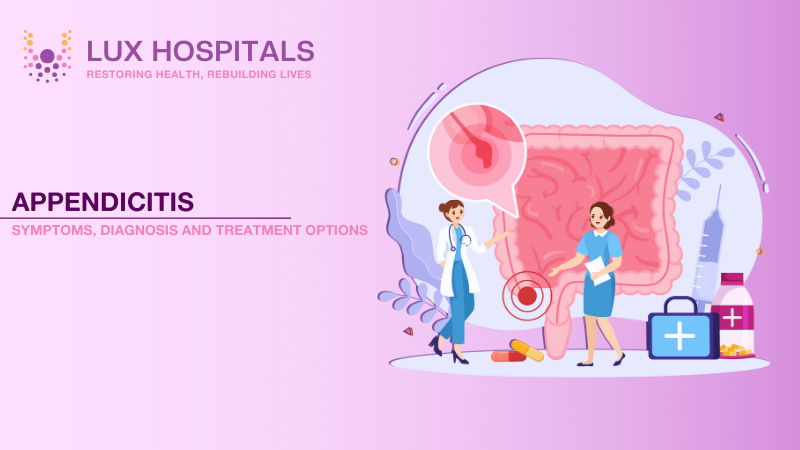Appendicitis: Symptoms, Diagnosis and Treatment Options

Appendicitis is a common condition that occurs when the appendix, a small pouch-like organ attached to the large intestine, becomes inflamed. Although its precise function remains unclear, the appendix can cause severe pain when it becomes infected or blocked. The inflammation of the appendix is known as appendicitis, and it can be a medical emergency requiring immediate attention.
This blog covers the symptoms, diagnosis, and treatment of appendicitis, with a focus on symptoms that may differ in women.
What is the Appendix?
The appendix is a small, tube-like structure located on the lower right side of the abdomen. It is attached to the cecum, the beginning part of the large intestine. Despite being a part of the digestive system, it is believed that the appendix has a minimal role in the body’s digestive processes.
Over time, scientists have suggested that the appendix may serve as a storehouse for beneficial bacteria, which can help in the recovery of the gut after an infection.
Symptoms of Appendicitis
The symptoms of appendicitis can vary, but a common sign is appendix pain, which often starts around the belly button and shifts to the lower right side of the abdomen. The pain can be sharp and sudden.
Common Symptoms:
- Abdominal Pain: Starts near the belly button, then shifts to the lower right abdomen.
- Loss of Appetite: Atypical hunger or no desire to eat.
- Nausea & Vomiting: Often follow abdominal pain.
- Fever: Typically mild, between 99°F and 102°F.
- Constipation or Diarrhea: Changes in bowel movements.
- Abdominal Swelling: A sign of inflammation.
Appendix Symptoms in Women:
In females, appendicitis symptoms can mimic other conditions, such as ovarian cysts or pelvic infections, which can complicate diagnosis. It’s essential to pay attention to symptom development and seek medical help.
How is Appendicitis Diagnosed?
A doctor will conduct a physical exam, followed by imaging tests and possibly lab tests.
- Physical Exam: A doctor may press on the abdomen to check for pain, particularly on the lower right side.
- Imaging Tests:
- Ultrasound: Commonly used for children and pregnant women.
- CT Scan: Most accurate for diagnosing appendicitis.
- MRI: Used for pregnant women to avoid radiation.
- Laboratory Tests: Blood and urine tests help assess infection and rule out other conditions.
Treatment Options for Appendicitis
The primary treatment for appendicitis is the removal of the inflamed appendix, typically through surgery. In some cases, antibiotics may be used first, especially if the appendicitis is diagnosed early or if there are complications.
1. Appendix Operation (Appendectomy)
The most common treatment for appendicitis is an appendectomy. There are two types of procedures:
- Laparoscopic Appendectomy: A minimally invasive surgery with small incisions and a camera (laparoscope) to remove the appendix. It offers quicker recovery, more minor scars, and less pain.
- Open Appendectomy: Involves a larger incision to remove the appendix. This is often done when the appendix has ruptured, or complications are present.
Both surgeries are performed under general anesthesia. Recovery times vary:
- Laparoscopic: Usually 1-3 weeks.
- Open: It takes 2-4 weeks for recovery.
2. Antibiotics & Non-Surgical Treatment
In mild or early cases of appendicitis, antibiotics may be used instead of immediate surgery. While antibiotics can reduce inflammation and help manage symptoms, surgery is typically recommended later to fully remove the appendix and prevent the infection from recurring.
3. Post-Surgery Care & Recovery
- Laparoscopic Appendectomy: Recovery is quick, with most patients returning to light activities in a few days. Complete recovery may take 1-2 weeks.
- Open Appendectomy: Recovery takes longer, and patients may need several weeks to resume normal activities.
During recovery, avoid strenuous activities and follow your surgeon’s instructions. This may include taking antibiotics and pain medications.
When to Seek Medical Attention?
Appendicitis requires immediate medical attention. If you’re experiencing sharp abdominal pain in the lower right side, along with fever, nausea, and vomiting, seek help right away. Delaying treatment can lead to a ruptured appendix, causing a life-threatening infection called peritonitis. Early detection and treatment can prevent complications and improve outcomes.
Conclusion
Appendicitis is a serious condition that requires prompt diagnosis and treatment. The appendix pain can be debilitating, but with timely intervention, the prognosis is generally good. Whether through an appendix operation or antibiotics for mild cases, treatment options are effective in managing appendicitis and preventing complications.It’s important to recognize appendix symptoms in female individuals, as they may sometimes be mistaken for other conditions. If you suspect appendicitis or experience related symptoms, seek medical attention immediately to ensure the best possible outcome.
Frequently Asked Questions
For appendicitis pain, you should consult a general surgeon at Lux Hospitals, as they specialize in conditions that may require surgery, such as appendicitis. If you’re unsure, you can first visit a general practitioner (GP) at Lux Hospitals, who can evaluate your symptoms and refer you to the appropriate specialist.
An appendix larger than 6 cm (2.4 inches) is considered dangerously enlarged and at higher risk of rupturing. Immediate medical attention is crucial to avoid severe complications.
The leading cause of appendicitis is typically a blockage in the appendix, often due to a buildup of mucus, stool, or infection. This blockage leads to inflammation, increased pressure, and infection in the appendix.
Appendicitis is most common in individuals between the ages of 10 and 30. It can occur at any age but is less frequent in older adults and young children.
You should call your healthcare provider if you experience persistent abdominal pain, especially in the lower right side, along with symptoms like fever, nausea, vomiting, or loss of appetite. These could be signs of appendicitis and require immediate medical attention.




















